深度学习之深L层神经网络
声明
本文参考(8条消息) 【中文】【吴恩达课后编程作业】Course 1 - 神经网络和深度学习 - 第四周作业(1&2)_何宽的博客-CSDN博客
力求自己理解,刚刚走进深度学习希望可以一起探索。
本文所使用的资料已上传到百度网盘【点击下载】,提取码:xx1w,请在开始之前下载好所需资料,并将资料与代码放在相同界面
在正式开始之前,我们先来了解一下我们要做什么。在本次教程中,我们要构建两个神经网络,一个是构建两层的神经网络,一个是构建多层的神经网络,多层神经网络的层数可以自己定义。本次的教程的难度有所提升,但是我会力求深入简出。在这里,我们简单的讲一下难点,本文会提到**[LINEAR-> ACTIVATION]转发函数,比如我有一个多层的神经网络,结构是输入层->隐藏层->隐藏层->···->隐藏层->输出层**,在每一层中,我会首先计算Z = np.dot(W,A) + b,这叫做【linear_forward】,然后再计算A = relu(Z) 或者 A = sigmoid(Z),这叫做【linear_activation_forward】,合并起来就是这一层的计算方法,所以每一层的计算都有两个步骤,先是计算Z,再计算A
流程图
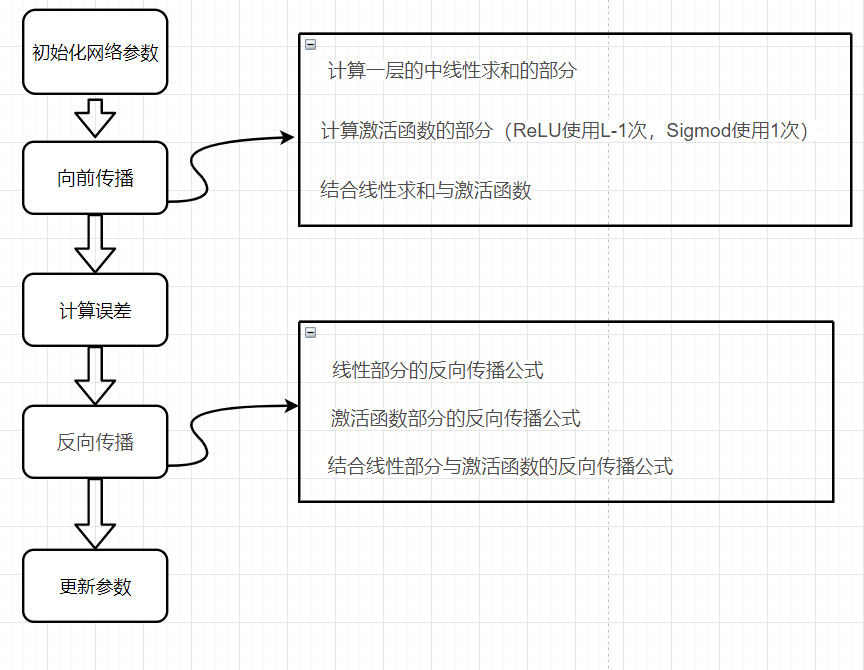
请注意,对于每个前向函数,都有一个相应的后向函数。 这就是为什么在我们的转发模块的每一步都会在cache中存储一些值,cache的值对计算梯度很有用,
在反向传播模块中,我们将使用cache来计算梯度。 现在我们正式开始分别构建两层神经网络和多层神经网络。这里很重要。
import numpy as np
import h5py
import matplotlib.pyplot as plt
import testCases #参见资料包
from dnn_utils import sigmoid, sigmoid_backward, relu, relu_backward #参见资料包
import lr_utils #参见资料包
为了和我的数据匹配,你需要指定随机种子
np.random.seed(1)
对于一个两层的的神经网络而言,如下图
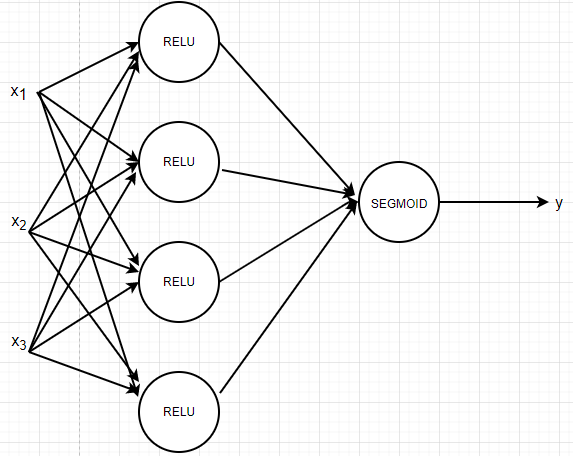
初始化参数如下
def initialize_parameters(n_x,n_h,n_y):
"""
此函数是为了初始化两层网络参数而使用的函数。
参数:
n_x - 输入层节点数量
n_h - 隐藏层节点数量
n_y - 输出层节点数量 返回:
parameters - 包含你的参数的python字典:
W1 - 权重矩阵,维度为(n_h,n_x)
b1 - 偏向量,维度为(n_h,1)
W2 - 权重矩阵,维度为(n_y,n_h)
b2 - 偏向量,维度为(n_y,1) """
W1 = np.random.randn(n_h, n_x) * 0.01
b1 = np.zeros((n_h, 1))
W2 = np.random.randn(n_y, n_h) * 0.01
b2 = np.zeros((n_y, 1)) #使用断言确保我的数据格式是正确的
assert(W1.shape == (n_h, n_x))
assert(b1.shape == (n_h, 1))
assert(W2.shape == (n_y, n_h))
assert(b2.shape == (n_y, 1)) parameters = {"W1": W1,
"b1": b1,
"W2": W2,
"b2": b2} return parameters
接下来,我们测试一下
print("==============测试initialize_parameters==============")
parameters = initialize_parameters(3,2,1)
print("W1 = " + str(parameters["W1"]))
print("b1 = " + str(parameters["b1"]))
print("W2 = " + str(parameters["W2"]))
print("b2 = " + str(parameters["b2"]))
==============测试initialize_parameters==============
W1 = [[ 0.01624345 -0.00611756 -0.00528172]
[-0.01072969 0.00865408 -0.02301539]]
b1 = [[0.]
[0.]]
W2 = [[ 0.01744812 -0.00761207]]
b2 = [[0.]]
两层的神经网络测试已经完毕了,那么对于一个L层的神经网络而言呢?初始化会是什么样的?
当然我们在大学都学过矩阵的乘法和加法吧,我们来看代码
def initialize_parameters_deep(layers_dims):
"""
此函数是为了初始化多层网络参数而使用的函数。
参数:
layers_dims - 包含我们网络中每个图层的节点数量的列表 返回:
parameters - 包含参数“W1”,“b1”,...,“WL”,“bL”的字典:
W1 - 权重矩阵,维度为(layers_dims [1],layers_dims [1-1])
bl - 偏向量,维度为(layers_dims [1],1)
"""
np.random.seed(3)
parameters = {}
L = len(layers_dims) for l in range(1,L):
parameters["W" + str(l)] = np.random.randn(layers_dims[l], layers_dims[l - 1]) / np.sqrt(layers_dims[l - 1]) # 这个根号其实和上面的0.01是一样目的的
parameters["b" + str(l)] = np.zeros((layers_dims[l], 1)) #确保我要的数据的格式是正确的
assert(parameters["W" + str(l)].shape == (layers_dims[l], layers_dims[l-1]))
assert(parameters["b" + str(l)].shape == (layers_dims[l], 1)) return parameters
我们来测试一下
#测试initialize_parameters_deep
print("==============测试initialize_parameters_deep==============")
layers_dims = [5,4,3]
parameters = initialize_parameters_deep(layers_dims)
print("W1 = " + str(parameters["W1"]))
print("b1 = " + str(parameters["b1"]))
print("W2 = " + str(parameters["W2"]))
print("b2 = " + str(parameters["b2"]))
==============测试initialize_parameters_deep==============
W1 = [[ 0.79989897 0.19521314 0.04315498 -0.83337927 -0.12405178]
[-0.15865304 -0.03700312 -0.28040323 -0.01959608 -0.21341839]
[-0.58757818 0.39561516 0.39413741 0.76454432 0.02237573]
[-0.18097724 -0.24389238 -0.69160568 0.43932807 -0.49241241]]
b1 = [[0.]
[0.]
[0.]
[0.]]
W2 = [[-0.59252326 -0.10282495 0.74307418 0.11835813]
[-0.51189257 -0.3564966 0.31262248 -0.08025668]
[-0.38441818 -0.11501536 0.37252813 0.98805539]]
b2 = [[0.]
[0.]
[0.]]
我们分别构建了两层和多层神经网络的初始化参数的函数,现在我们开始构建前向传播函数。
向前传播函数
- LINEAR
- LINEAR - >ACTIVATION,其中激活函数将会使用ReLU或Sigmoid。
- [LINEAR - > RELU] ×(L-1) - > LINEAR - > SIGMOID(整个模型)

线性部分【LINEAR】
前向传播中,线性部分计算如下:
def linear_forward(A,W,b):
"""
实现前向传播的线性部分。 参数:
A - 来自上一层(或输入数据)的激活,维度为(上一层的节点数量,示例的数量)
W - 权重矩阵,numpy数组,维度为(当前图层的节点数量,前一图层的节点数量)
b - 偏向量,numpy向量,维度为(当前图层节点数量,1) 返回:
Z - 激活功能的输入,也称为预激活参数
cache - 一个包含“A”,“W”和“b”的字典,存储这些变量以有效地计算后向传递
"""
Z = np.dot(W,A) + b
assert(Z.shape == (W.shape[0],A.shape[1]))
cache = (A,W,b) return Z,cache
我们来测试一下:
#测试linear_forward
print("==============测试linear_forward==============")
A,W,b = testCases.linear_forward_test_case()
Z,linear_cache = linear_forward(A,W,b)
print("Z = " + str(Z))
==============测试linear_forward==============
Z = [[ 3.26295337 -1.23429987]]
线性激活部分【LINEAR - >ACTIVATION】
我们为了实现LINEAR->ACTIVATION这个步骤, 使用的公式是:A[l]=g(z[l])=g(W[l]A[l-1]+b[l]),其中,函数g会是sigmoid() 或者是 relu(),当然sigmoid()只在输出层使用,现在我们正式构建前向线性激活部分。
我们发现在同一层中A的序列号总是会少1。
def linear_activation_forward(A_prev,W,b,activation):
"""
实现LINEAR-> ACTIVATION 这一层的前向传播 参数:
A_prev - 来自上一层(或输入层)的激活,维度为(上一层的节点数量,示例数)
W - 权重矩阵,numpy数组,维度为(当前层的节点数量,前一层的大小)
b - 偏向量,numpy阵列,维度为(当前层的节点数量,1)
activation - 选择在此层中使用的激活函数名,字符串类型,【"sigmoid" | "relu"】 返回:
A - 激活函数的输出,也称为激活后的值
cache - 一个包含“linear_cache”和“activation_cache”的字典,我们需要存储它以有效地计算后向传递
""" if activation == "sigmoid":
Z, linear_cache = linear_forward(A_prev, W, b)
A, activation_cache = sigmoid(Z)
elif activation == "relu":
Z, linear_cache = linear_forward(A_prev, W, b)
A, activation_cache = relu(Z) assert(A.shape == (W.shape[0],A_prev.shape[1]))
cache = (linear_cache,activation_cache) return A,cache
我们来测试一下:
#测试linear_activation_forward
print("==============测试linear_activation_forward==============")
A_prev, W,b = testCases.linear_activation_forward_test_case() A, linear_activation_cache = linear_activation_forward(A_prev, W, b, activation = "sigmoid")
print("sigmoid,A = " + str(A)) A, linear_activation_cache = linear_activation_forward(A_prev, W, b, activation = "relu")
print("ReLU,A = " + str(A))
==============测试linear_activation_forward==============
sigmoid,A = [[0.96890023 0.11013289]]
ReLU,A = [[3.43896131 0. ]]
我们把两层模型需要的前向传播函数做完了,那多层网络模型的前向传播是怎样的呢?我们调用上面的那两个函数来实现它,为了在实现L层神经网络时更加方便,
我们需要一个函数来复制前一个函数(带有RELU的linear_activation_forward)L-1次,然后用一个带有SIGMOID的linear_activation_forward跟踪它,
我们来看一下它的结构是怎样的: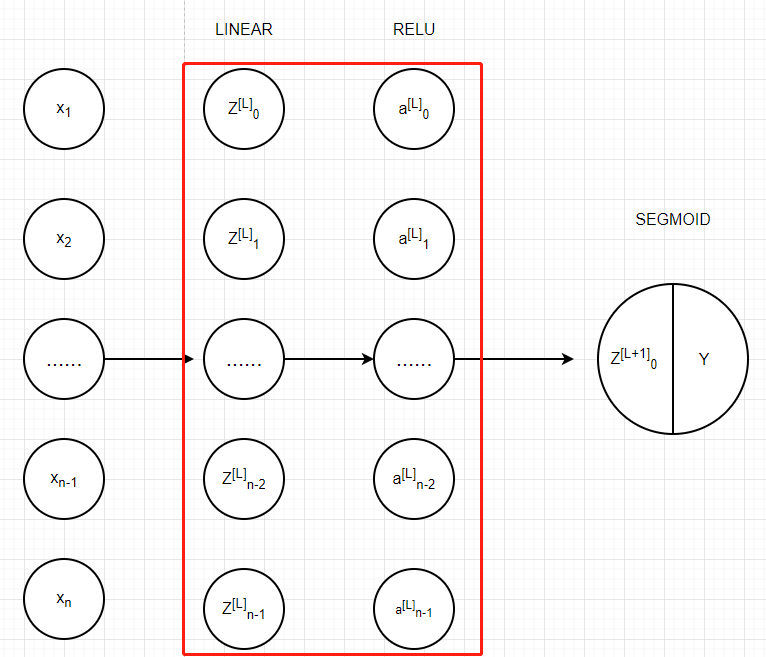
在下面的代码中,AL表示A[L]=g(Z[L])=g(W[L]A[L-1]+b[L]),(也可称作 Y_hat)
多层模型的前向传播计算模型代码如下:
def L_model_forward(X,parameters):
"""
实现[LINEAR-> RELU] *(L-1) - > LINEAR-> SIGMOID计算前向传播,也就是多层网络的前向传播,为后面每一层都执行LINEAR和ACTIVATION 参数:
X - 数据,numpy数组,维度为(输入节点数量,示例数)
parameters - initialize_parameters_deep()的输出 返回:
AL - 最后的激活值
caches - 包含以下内容的缓存列表:
linear_relu_forward()的每个cache(有L-1个,索引为从0到L-2)
linear_sigmoid_forward()的cache(只有一个,索引为L-1)
"""
caches = []
A = X
L = len(parameters) // 2 # 因为有两个参数(W,b)因此要整除以2
for l in range(1,L):
A_prev = A
A, cache = linear_activation_forward(A_prev, parameters['W' + str(l)], parameters['b' + str(l)], "relu")
caches.append(cache) AL, cache = linear_activation_forward(A, parameters['W' + str(L)], parameters['b' + str(L)], "sigmoid")
caches.append(cache) assert(AL.shape == (1,X.shape[1])) return AL,caches
我们来测试一下:
#测试L_model_forward
print("==============测试L_model_forward==============")
X,parameters = testCases.L_model_forward_test_case()
AL,caches = L_model_forward(X,parameters)
print("AL = " + str(AL))
print("caches 的长度为 = " + str(len(caches)))
==============测试L_model_forward==============
AL = [[0.17007265 0.2524272 ]]
caches 的长度为 = 2
计算成本
我们已经把这两个模型的前向传播部分完成了,我们需要计算成本(误差),以确定它到底有没有在学习,成本的计算公式如:

def compute_cost(AL,Y):
"""
上面定义的成本函数。 参数:
AL - 与标签预测相对应的概率向量,维度为(1,示例数量)
Y - 标签向量(例如:如果不是猫,则为0,如果是猫则为1),维度为(1,数量) 返回:
cost - 交叉熵成本
"""
m = Y.shape[1]
cost = -np.sum(np.multiply(np.log(AL),Y) + np.multiply(np.log(1 - AL), 1 - Y)) / m cost = np.squeeze(cost)
assert(cost.shape == ()) return cost
我们来测试一下:
#测试compute_cost
print("==============测试compute_cost==============")
Y,AL = testCases.compute_cost_test_case()
print("cost = " + str(compute_cost(AL, Y)))
==============测试compute_cost==============
cost = 0.414931599615397
我们已经把误差值计算出来了,现在开始进行反向传播
反向传播
反向传播用于计算相对于参数的损失函数的梯度,我们来看看向前和向后传播的流程图:
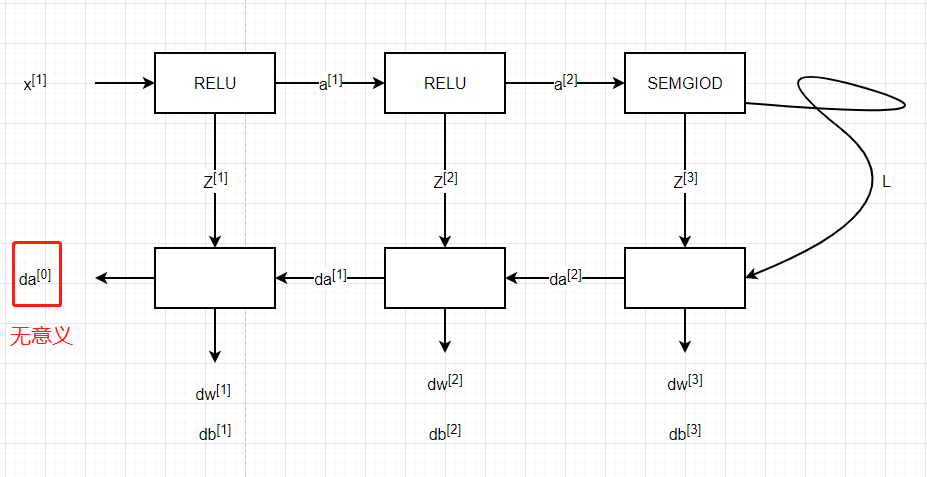
与前向传播类似,我们有需要使用三个步骤来构建反向传播:
LINEAR 后向计算
LINEAR -> ACTIVATION 后向计算,其中ACTIVATION 计算Relu或者Sigmoid 的结果
[LINEAR -> RELU] × \times× (L-1) -> LINEAR -> SIGMOID 后向计算 (整个模型)
线性部分【LINEAR backward】
我们来实现后向传播线性部分:
def linear_backward(dZ,cache):
"""
为单层实现反向传播的线性部分(第L层) 参数:
dZ - 相对于(当前第l层的)线性输出的成本梯度
cache - 来自当前层前向传播的值的元组(A_prev,W,b) 返回:
dA_prev - 相对于激活(前一层l-1)的成本梯度,与A_prev维度相同
dW - 相对于W(当前层l)的成本梯度,与W的维度相同
db - 相对于b(当前层l)的成本梯度,与b维度相同
"""
A_prev, W, b = cache
m = A_prev.shape[1]
dW = np.dot(dZ, A_prev.T) / m
db = np.sum(dZ, axis=1, keepdims=True) / m
dA_prev = np.dot(W.T, dZ) assert (dA_prev.shape == A_prev.shape)
assert (dW.shape == W.shape)
assert (db.shape == b.shape) return dA_prev, dW, db
我们来测试一下:
#测试linear_backward
print("==============测试linear_backward==============")
dZ, linear_cache = testCases.linear_backward_test_case() dA_prev, dW, db = linear_backward(dZ, linear_cache)
print ("dA_prev = "+ str(dA_prev))
print ("dW = " + str(dW))
print ("db = " + str(db))
==============测试linear_backward==============
dA_prev = [[ 0.51822968 -0.19517421]
[-0.40506361 0.15255393]
[ 2.37496825 -0.89445391]]
dW = [[-0.10076895 1.40685096 1.64992505]]
db = [[0.50629448]]
线性激活部分【LINEAR -> ACTIVATION backward】
如果 g ( . ) 是激活函数, 那么sigmoid_backward 和 relu_backward 这样计算:dZ[L]=dA[L]*g(Z[L])
我们先在正式开始实现后向线性激活:
def linear_activation_backward(dA,cache,activation="relu"):
"""
实现LINEAR-> ACTIVATION层的后向传播。 参数:
dA - 当前层l的激活后的梯度值
cache - 我们存储的用于有效计算反向传播的值的元组(值为linear_cache,activation_cache)
activation - 要在此层中使用的激活函数名,字符串类型,【"sigmoid" | "relu"】
返回:
dA_prev - 相对于激活(前一层l-1)的成本梯度值,与A_prev维度相同
dW - 相对于W(当前层l)的成本梯度值,与W的维度相同
db - 相对于b(当前层l)的成本梯度值,与b的维度相同
"""
linear_cache, activation_cache = cache
if activation == "relu":
dZ = relu_backward(dA, activation_cache)
dA_prev, dW, db = linear_backward(dZ, linear_cache)
elif activation == "sigmoid":
dZ = sigmoid_backward(dA, activation_cache)
dA_prev, dW, db = linear_backward(dZ, linear_cache) return dA_prev,dW,db
下面我们来测试一下:
#测试linear_activation_backward
print("==============测试linear_activation_backward==============")
AL, linear_activation_cache = testCases.linear_activation_backward_test_case() dA_prev, dW, db = linear_activation_backward(AL, linear_activation_cache, activation = "sigmoid")
print ("sigmoid:")
print ("dA_prev = "+ str(dA_prev))
print ("dW = " + str(dW))
print ("db = " + str(db) + "\n") dA_prev, dW, db = linear_activation_backward(AL, linear_activation_cache, activation = "relu")
print ("relu:")
print ("dA_prev = "+ str(dA_prev))
print ("dW = " + str(dW))
print ("db = " + str(db))
==============测试linear_activation_backward==============
sigmoid:
dA_prev = [[ 0.11017994 0.01105339]
[ 0.09466817 0.00949723]
[-0.05743092 -0.00576154]]
dW = [[ 0.10266786 0.09778551 -0.01968084]]
db = [[-0.05729622]] relu:
dA_prev = [[ 0.44090989 -0. ]
[ 0.37883606 -0. ]
[-0.2298228 0. ]]
dW = [[ 0.44513824 0.37371418 -0.10478989]]
db = [[-0.20837892]]
我们已经把两层模型的后向计算完成了,对于多层模型我们也需要这两个函数来完成,我们来看一下流程图:
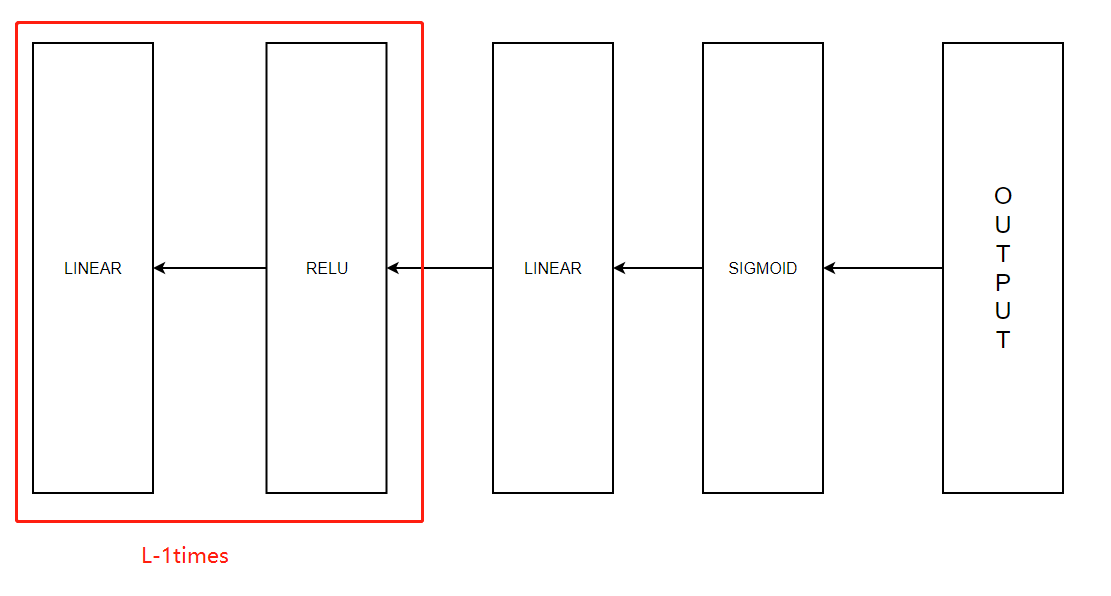
在之前的前向计算中,我们存储了一些包含包含(X,W,b和Z)的cache,我们将会使用它们来计算梯度值,
所以,在L层模型中,我们需要从L层遍历所有的隐藏层,在每一步中,我们需要使用那一层的cache值来进行反向传播。
我们开始构建多层模型向后传播函数:
def L_model_backward(AL,Y,caches):
"""
对[LINEAR-> RELU] *(L-1) - > LINEAR - > SIGMOID组执行反向传播,就是多层网络的向后传播 参数:
AL - 概率向量,正向传播的输出(L_model_forward())
Y - 标签向量(例如:如果不是猫,则为0,如果是猫则为1),维度为(1,数量)
caches - 包含以下内容的cache列表:
linear_activation_forward("relu")的cache,不包含输出层
linear_activation_forward("sigmoid")的cache 返回:
grads - 具有梯度值的字典
grads [“dA”+ str(l)] = ...
grads [“dW”+ str(l)] = ...
grads [“db”+ str(l)] = ...
"""
grads = {}
L = len(caches)
m = AL.shape[1]
Y = Y.reshape(AL.shape)
dAL = - (np.divide(Y, AL) - np.divide(1 - Y, 1 - AL)) current_cache = caches[L-1]
grads["dA" + str(L)], grads["dW" + str(L)], grads["db" + str(L)] = linear_activation_backward(dAL, current_cache, "sigmoid") for l in reversed(range(L-1)):
current_cache = caches[l]
dA_prev_temp, dW_temp, db_temp = linear_activation_backward(grads["dA" + str(l+2)], current_cache, "relu")
grads["dA" + str(l + 1)] = dA_prev_temp
grads["dW" + str(l + 1)] = dW_temp
grads["db" + str(l + 1)] = db_temp return grads
相信第一次看到for循环的小伙伴会跟我一样懵,我以我自己的理解来说明:
在同一层a的序号总是比W,b少1;
reversed将列表逆序变成了[L-2,L-3,L-4.....,2,1,0],又因为W没有dw[0],subsequent全员+1;
千万不要认为str(l+2)是L-2+2=L,列表的顺序依旧是[0,1,2,3,4...],所以str(l+2)是str(0+2)=str(2)
测试一下:
测试L_model_backward
print("==============测试L_model_backward==============")
AL, Y_assess, caches = testCases.L_model_backward_test_case()
grads = L_model_backward(AL, Y_assess, caches)
print ("dW1 = "+ str(grads["dW1"]))
print ("db1 = "+ str(grads["db1"]))
print ("dA0 = "+ str(grads["dA1"]))
==============测试L_model_backward==============
dW1 = [[0.41010002 0.07807203 0.13798444 0.10502167]
[0. 0. 0. 0. ]
[0.05283652 0.01005865 0.01777766 0.0135308 ]]
db1 = [[-0.22007063]
[ 0. ]
[-0.02835349]]
dA0 = [[ 0.12913162 -0.44014127]
[-0.14175655 0.48317296]
[ 0.01663708 -0.05670698]]
更新参数
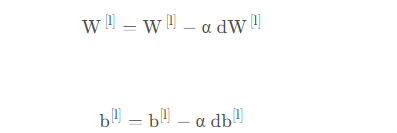
def update_parameters(parameters, grads, learning_rate):
"""
使用梯度下降更新参数 参数:
parameters - 包含你的参数的字典
grads - 包含梯度值的字典,是L_model_backward的输出 返回:
parameters - 包含更新参数的字典
参数[“W”+ str(l)] = ...
参数[“b”+ str(l)] = ...
"""
L = len(parameters) // 2 #整除
for l in range(L):
parameters["W" + str(l + 1)] = parameters["W" + str(l + 1)] - learning_rate * grads["dW" + str(l + 1)]
parameters["b" + str(l + 1)] = parameters["b" + str(l + 1)] - learning_rate * grads["db" + str(l + 1)] return parameters
测试一下:
#测试update_parameters
print("==============测试update_parameters==============")
parameters, grads = testCases.update_parameters_test_case()
parameters = update_parameters(parameters, grads, 0.1) print ("W1 = "+ str(parameters["W1"]))
print ("b1 = "+ str(parameters["b1"]))
print ("W2 = "+ str(parameters["W2"]))
print ("b2 = "+ str(parameters["b2"]))
==============测试update_parameters==============
W1 = [[-0.59562069 -0.09991781 -2.14584584 1.82662008]
[-1.76569676 -0.80627147 0.51115557 -1.18258802]
[-1.0535704 -0.86128581 0.68284052 2.20374577]]
b1 = [[-0.04659241]
[-1.28888275]
[ 0.53405496]]
W2 = [[-0.55569196 0.0354055 1.32964895]]
b2 = [[-0.84610769]]
至此为止,我们已经实现该神经网络中所有需要的函数。接下来,我们将这些方法组合在一起,构成一个神经网络类,可以方便的使用。
建立两层的神经网络:
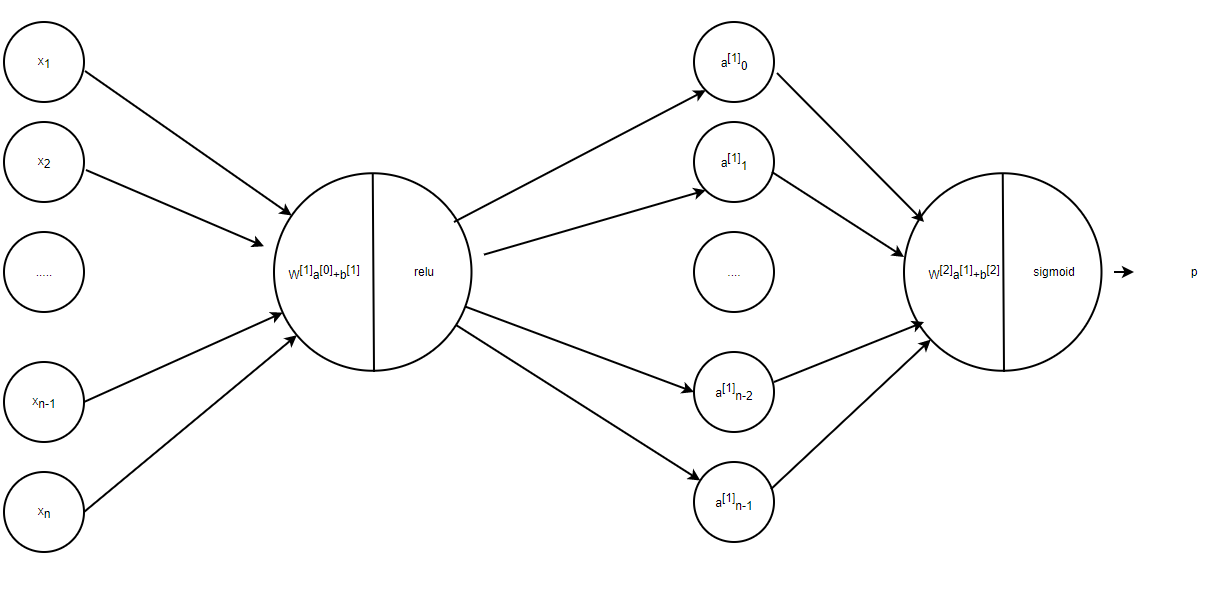
我们正式开始构建两层的神经网络:
def two_layer_model(X,Y,layers_dims,learning_rate=0.0075,num_iterations=3000,print_cost=False,isPlot=True):
"""
实现一个两层的神经网络,【LINEAR->RELU】 -> 【LINEAR->SIGMOID】
参数:
X - 输入的数据,维度为(n_x,例子数)
Y - 标签,向量,0为非猫,1为猫,维度为(1,数量)
layers_dims - 层数的向量,维度为(n_y,n_h,n_y)
learning_rate - 学习率
num_iterations - 迭代的次数
print_cost - 是否打印成本值,每100次打印一次
isPlot - 是否绘制出误差值的图谱
返回:
parameters - 一个包含W1,b1,W2,b2的字典变量
"""
np.random.seed(1)
grads = {}
costs = []
(n_x,n_h,n_y) = layers_dims """
初始化参数
"""
parameters = initialize_parameters(n_x, n_h, n_y) W1 = parameters["W1"]
b1 = parameters["b1"]
W2 = parameters["W2"]
b2 = parameters["b2"] """
开始进行迭代
"""
for i in range(0,num_iterations):
#前向传播
A1, cache1 = linear_activation_forward(X, W1, b1, "relu")
A2, cache2 = linear_activation_forward(A1, W2, b2, "sigmoid") #计算成本
cost = compute_cost(A2,Y) #后向传播
##初始化后向传播
dA2 = - (np.divide(Y, A2) - np.divide(1 - Y, 1 - A2)) ##向后传播,输入:“dA2,cache2,cache1”。 输出:“dA1,dW2,db2;还有dA0(未使用),dW1,db1”。
dA1, dW2, db2 = linear_activation_backward(dA2, cache2, "sigmoid")
dA0, dW1, db1 = linear_activation_backward(dA1, cache1, "relu") ##向后传播完成后的数据保存到grads
grads["dW1"] = dW1
grads["db1"] = db1
grads["dW2"] = dW2
grads["db2"] = db2 #更新参数
parameters = update_parameters(parameters,grads,learning_rate)
W1 = parameters["W1"]
b1 = parameters["b1"]
W2 = parameters["W2"]
b2 = parameters["b2"] #打印成本值,如果print_cost=False则忽略
if i % 100 == 0:
#记录成本
costs.append(cost)
#是否打印成本值
if print_cost:
print("第", i ,"次迭代,成本值为:" ,np.squeeze(cost))
#迭代完成,根据条件绘制图
if isPlot:
plt.plot(np.squeeze(costs))
plt.ylabel('cost')
plt.xlabel('iterations (per tens)')
plt.title("Learning rate =" + str(learning_rate))
plt.show() #返回parameters
return parameters
train_set_x_orig , train_set_y , test_set_x_orig , test_set_y , classes = lr_utils.load_dataset() train_x_flatten = train_set_x_orig.reshape(train_set_x_orig.shape[0], -1).T
test_x_flatten = test_set_x_orig.reshape(test_set_x_orig.shape[0], -1).T train_x = train_x_flatten / 255
train_y = train_set_y
test_x = test_x_flatten / 255
test_y = test_set_y
数据集加载完成,开始正式训练:
n_x = 12288
n_h = 7
n_y = 1
layers_dims = (n_x,n_h,n_y) parameters = two_layer_model(train_x, train_set_y, layers_dims = (n_x, n_h, n_y), num_iterations = 2500, print_cost=True,isPlot=True)
第 0 次迭代,成本值为: 0.6930497356599891
第 100 次迭代,成本值为: 0.6464320953428849
第 200 次迭代,成本值为: 0.6325140647912677
第 300 次迭代,成本值为: 0.6015024920354665
第 400 次迭代,成本值为: 0.5601966311605748
第 500 次迭代,成本值为: 0.515830477276473
第 600 次迭代,成本值为: 0.47549013139433266
第 700 次迭代,成本值为: 0.4339163151225749
第 800 次迭代,成本值为: 0.400797753620389
第 900 次迭代,成本值为: 0.3580705011323798
第 1000 次迭代,成本值为: 0.3394281538366412
第 1100 次迭代,成本值为: 0.30527536361962637
第 1200 次迭代,成本值为: 0.27491377282130186
第 1300 次迭代,成本值为: 0.2468176821061483
第 1400 次迭代,成本值为: 0.19850735037466102
第 1500 次迭代,成本值为: 0.1744831811255663
第 1600 次迭代,成本值为: 0.17080762978097416
第 1700 次迭代,成本值为: 0.11306524562164691
第 1800 次迭代,成本值为: 0.09629426845937152
第 1900 次迭代,成本值为: 0.08342617959726865
第 2000 次迭代,成本值为: 0.07439078704319084
第 2100 次迭代,成本值为: 0.06630748132267936
第 2200 次迭代,成本值为: 0.05919329501038171
第 2300 次迭代,成本值为: 0.05336140348560559
第 2400 次迭代,成本值为: 0.04855478562877018
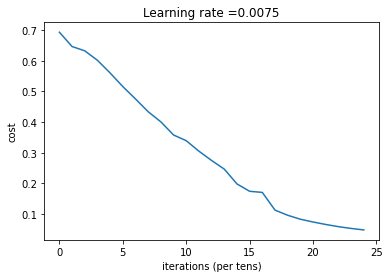
迭代完成之后我们就可以进行预测了,预测函数如下:
def predict(X, y, parameters):
"""
该函数用于预测L层神经网络的结果,当然也包含两层 参数:
X - 测试集
y - 标签
parameters - 训练模型的参数 返回:
p - 给定数据集X的预测
""" m = X.shape[1]
n = len(parameters) // 2 # 神经网络的层数
p = np.zeros((1,m)) #根据参数前向传播
probas, caches = L_model_forward(X, parameters) for i in range(0, probas.shape[1]):
if probas[0,i] > 0.5:
p[0,i] = 1
else:
p[0,i] = 0 print("准确度为: " + str(float(np.sum((p == y))/m))) return p
预测函数构建好了我们就开始预测,查看训练集和测试集的准确性:
predictions_train = predict(train_x, train_y, parameters) #训练集
predictions_test = predict(test_x, test_y, parameters) #测试集
准确度为: 1.0
准确度为: 0.72
搭建多层神经网络
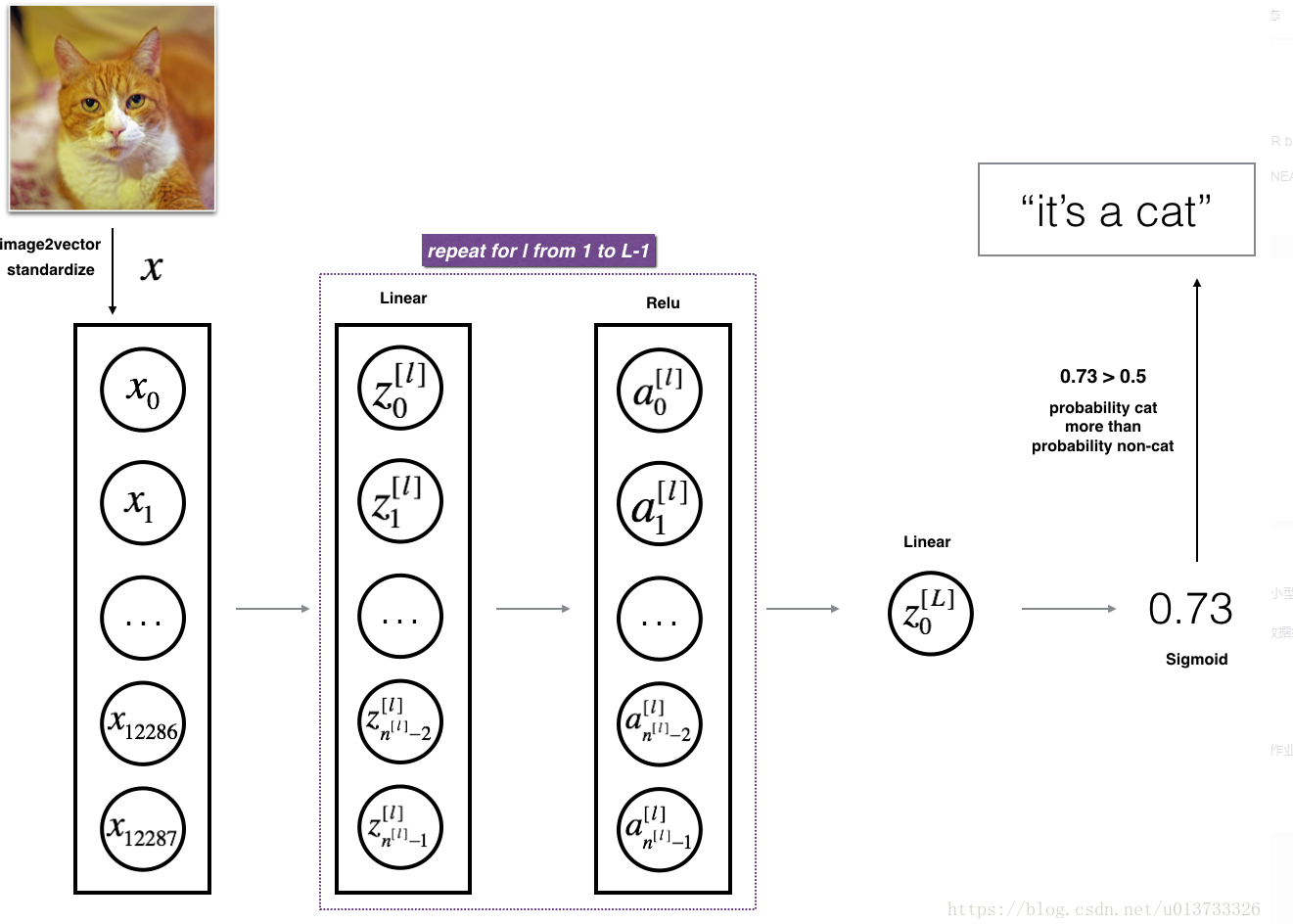
def L_layer_model(X, Y, layers_dims, learning_rate=0.0075, num_iterations=3000, print_cost=False,isPlot=True):
"""
实现一个L层神经网络:[LINEAR-> RELU] *(L-1) - > LINEAR-> SIGMOID。 参数:
X - 输入的数据,维度为(n_x,例子数)
Y - 标签,向量,0为非猫,1为猫,维度为(1,数量)
layers_dims - 层数的向量,维度为(n_y,n_h,···,n_h,n_y)
learning_rate - 学习率
num_iterations - 迭代的次数
print_cost - 是否打印成本值,每100次打印一次
isPlot - 是否绘制出误差值的图谱 返回:
parameters - 模型学习的参数。 然后他们可以用来预测。
"""
np.random.seed(1)
costs = [] parameters = initialize_parameters_deep(layers_dims) for i in range(0,num_iterations):
AL , caches = L_model_forward(X,parameters) cost = compute_cost(AL,Y) grads = L_model_backward(AL,Y,caches) parameters = update_parameters(parameters,grads,learning_rate) #打印成本值,如果print_cost=False则忽略
if i % 100 == 0:
#记录成本
costs.append(cost)
#是否打印成本值
if print_cost:
print("第", i ,"次迭代,成本值为:" ,np.squeeze(cost))
#迭代完成,根据条件绘制图
if isPlot:
plt.plot(np.squeeze(costs))
plt.ylabel('cost')
plt.xlabel('iterations (per tens)')
plt.title("Learning rate =" + str(learning_rate))
plt.show()
return parameters
我们现在开始加载数据集:
train_set_x_orig , train_set_y , test_set_x_orig , test_set_y , classes = lr_utils.load_dataset() train_x_flatten = train_set_x_orig.reshape(train_set_x_orig.shape[0], -1).T
test_x_flatten = test_set_x_orig.reshape(test_set_x_orig.shape[0], -1).T train_x = train_x_flatten / 255
train_y = train_set_y
test_x = test_x_flatten / 255
test_y = test_set_y
数据集加载完成,开始正式训练:
layers_dims = [12288, 20, 7, 5, 1] # 5-layer model
parameters = L_layer_model(train_x, train_y, layers_dims, num_iterations = 2500, print_cost = True,isPlot=True)
第 0 次迭代,成本值为: 0.715731513413713
第 100 次迭代,成本值为: 0.6747377593469114
第 200 次迭代,成本值为: 0.6603365433622127
第 300 次迭代,成本值为: 0.6462887802148751
第 400 次迭代,成本值为: 0.6298131216927773
第 500 次迭代,成本值为: 0.6060056229265339
第 600 次迭代,成本值为: 0.5690041263975134
第 700 次迭代,成本值为: 0.5197965350438059
第 800 次迭代,成本值为: 0.46415716786282285
第 900 次迭代,成本值为: 0.40842030048298916
第 1000 次迭代,成本值为: 0.37315499216069037
第 1100 次迭代,成本值为: 0.30572374573047123
第 1200 次迭代,成本值为: 0.2681015284774084
第 1300 次迭代,成本值为: 0.23872474827672574
第 1400 次迭代,成本值为: 0.20632263257914704
第 1500 次迭代,成本值为: 0.17943886927493524
第 1600 次迭代,成本值为: 0.15798735818801113
第 1700 次迭代,成本值为: 0.14240413012273798
第 1800 次迭代,成本值为: 0.1286516599788517
第 1900 次迭代,成本值为: 0.11244314998153365
第 2000 次迭代,成本值为: 0.08505631034962911
第 2100 次迭代,成本值为: 0.05758391198603161
第 2200 次迭代,成本值为: 0.04456753454692599
第 2300 次迭代,成本值为: 0.038082751665970464
第 2400 次迭代,成本值为: 0.034410749018399016
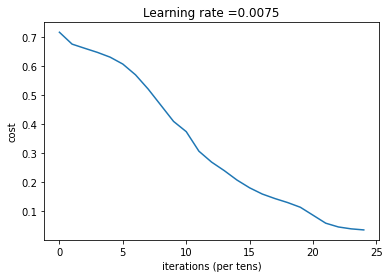
训练完成,我们看一下预测:
pred_train = predict(train_x, train_y, parameters) #训练集
pred_test = predict(test_x, test_y, parameters) #测试集
准确度为: 0.9952153110047847
准确度为: 0.78
72%再到78%,可以看到的是准确度在一点点增加,当然,你也可以手动的去调整layers_dims,准确度可能又会提高一些。
分析
def print_mislabeled_images(classes, X, y, p):
"""
绘制预测和实际不同的图像。
X - 数据集
y - 实际的标签
p - 预测
"""
a = p + y
mislabeled_indices = np.asarray(np.where(a == 1))
plt.rcParams['figure.figsize'] = (40.0, 40.0) # set default size of plots
num_images = len(mislabeled_indices[0])
for i in range(num_images):
index = mislabeled_indices[1][i] plt.subplot(2, num_images, i + 1)
plt.imshow(X[:,index].reshape(64,64,3), interpolation='nearest')
plt.axis('off')
plt.title("Prediction: " + classes[int(p[0,index])].decode("utf-8") + " \n Class: " + classes[y[0,index]].decode("utf-8")) print_mislabeled_images(classes, test_x, test_y, pred_test)
 分析一下我们就可以得知原因了:
分析一下我们就可以得知原因了:
模型往往表现欠佳的几种类型的图像包括:
- 猫身体在一个不同的位置
- 猫出现在相似颜色的背景下
- 不同的猫的颜色和品种
- 相机角度
- 图片的亮度
- 比例变化(猫的图像非常大或很小)
相关库代码
lr_utils.py
# lr_utils.py
import numpy as np
import h5py def load_dataset():
train_dataset = h5py.File('datasets/train_catvnoncat.h5', "r")
train_set_x_orig = np.array(train_dataset["train_set_x"][:]) # your train set features
train_set_y_orig = np.array(train_dataset["train_set_y"][:]) # your train set labels test_dataset = h5py.File('datasets/test_catvnoncat.h5', "r")
test_set_x_orig = np.array(test_dataset["test_set_x"][:]) # your test set features
test_set_y_orig = np.array(test_dataset["test_set_y"][:]) # your test set labels classes = np.array(test_dataset["list_classes"][:]) # the list of classes train_set_y_orig = train_set_y_orig.reshape((1, train_set_y_orig.shape[0]))
test_set_y_orig = test_set_y_orig.reshape((1, test_set_y_orig.shape[0])) return train_set_x_orig, train_set_y_orig, test_set_x_orig, test_set_y_orig, classes
dnn_utils.py
# dnn_utils.py
import numpy as np def sigmoid(Z):
"""
Implements the sigmoid activation in numpy Arguments:
Z -- numpy array of any shape Returns:
A -- output of sigmoid(z), same shape as Z
cache -- returns Z as well, useful during backpropagation
""" A = 1/(1+np.exp(-Z))
cache = Z return A, cache def sigmoid_backward(dA, cache):
"""
Implement the backward propagation for a single SIGMOID unit. Arguments:
dA -- post-activation gradient, of any shape
cache -- 'Z' where we store for computing backward propagation efficiently Returns:
dZ -- Gradient of the cost with respect to Z
""" Z = cache s = 1/(1+np.exp(-Z))
dZ = dA * s * (1-s) assert (dZ.shape == Z.shape) return dZ def relu(Z):
"""
Implement the RELU function. Arguments:
Z -- Output of the linear layer, of any shape Returns:
A -- Post-activation parameter, of the same shape as Z
cache -- a python dictionary containing "A" ; stored for computing the backward pass efficiently
""" A = np.maximum(0,Z) assert(A.shape == Z.shape) cache = Z
return A, cache def relu_backward(dA, cache):
"""
Implement the backward propagation for a single RELU unit. Arguments:
dA -- post-activation gradient, of any shape
cache -- 'Z' where we store for computing backward propagation efficiently Returns:
dZ -- Gradient of the cost with respect to Z
""" Z = cache
dZ = np.array(dA, copy=True) # just converting dz to a correct object. # When z <= 0, you should set dz to 0 as well.
dZ[Z <= 0] = 0 assert (dZ.shape == Z.shape) return dZ
testCase.py
#testCase.py
import numpy as np def linear_forward_test_case():
np.random.seed(1)
A = np.random.randn(3,2)
W = np.random.randn(1,3)
b = np.random.randn(1,1) return A, W, b def linear_activation_forward_test_case():
np.random.seed(2)
A_prev = np.random.randn(3,2)
W = np.random.randn(1,3)
b = np.random.randn(1,1)
return A_prev, W, b def L_model_forward_test_case():
np.random.seed(1)
X = np.random.randn(4,2)
W1 = np.random.randn(3,4)
b1 = np.random.randn(3,1)
W2 = np.random.randn(1,3)
b2 = np.random.randn(1,1)
parameters = {"W1": W1,
"b1": b1,
"W2": W2,
"b2": b2} return X, parameters def compute_cost_test_case():
Y = np.asarray([[1, 1, 1]])
aL = np.array([[.8,.9,0.4]]) return Y, aL def linear_backward_test_case():
np.random.seed(1)
dZ = np.random.randn(1,2)
A = np.random.randn(3,2)
W = np.random.randn(1,3)
b = np.random.randn(1,1)
linear_cache = (A, W, b)
return dZ, linear_cache def linear_activation_backward_test_case():
np.random.seed(2)
dA = np.random.randn(1,2)
A = np.random.randn(3,2)
W = np.random.randn(1,3)
b = np.random.randn(1,1)
Z = np.random.randn(1,2)
linear_cache = (A, W, b)
activation_cache = Z
linear_activation_cache = (linear_cache, activation_cache) return dA, linear_activation_cache def L_model_backward_test_case():
np.random.seed(3)
AL = np.random.randn(1, 2)
Y = np.array([[1, 0]]) A1 = np.random.randn(4,2)
W1 = np.random.randn(3,4)
b1 = np.random.randn(3,1)
Z1 = np.random.randn(3,2)
linear_cache_activation_1 = ((A1, W1, b1), Z1) A2 = np.random.randn(3,2)
W2 = np.random.randn(1,3)
b2 = np.random.randn(1,1)
Z2 = np.random.randn(1,2)
linear_cache_activation_2 = ( (A2, W2, b2), Z2) caches = (linear_cache_activation_1, linear_cache_activation_2) return AL, Y, caches def update_parameters_test_case():
np.random.seed(2)
W1 = np.random.randn(3,4)
b1 = np.random.randn(3,1)
W2 = np.random.randn(1,3)
b2 = np.random.randn(1,1)
parameters = {"W1": W1,
"b1": b1,
"W2": W2,
"b2": b2}
np.random.seed(3)
dW1 = np.random.randn(3,4)
db1 = np.random.randn(3,1)
dW2 = np.random.randn(1,3)
db2 = np.random.randn(1,1)
grads = {"dW1": dW1,
"db1": db1,
"dW2": dW2,
"db2": db2} return parameters, grads
深度学习之深L层神经网络的更多相关文章
- TensorFlow 2.0 深度学习实战 —— 浅谈卷积神经网络 CNN
前言 上一章为大家介绍过深度学习的基础和多层感知机 MLP 的应用,本章开始将深入讲解卷积神经网络的实用场景.卷积神经网络 CNN(Convolutional Neural Networks,Conv ...
- 深度学习与CV教程(4) | 神经网络与反向传播
作者:韩信子@ShowMeAI 教程地址:http://www.showmeai.tech/tutorials/37 本文地址:http://www.showmeai.tech/article-det ...
- 深度学习与CV教程(6) | 神经网络训练技巧 (上)
作者:韩信子@ShowMeAI 教程地址:http://www.showmeai.tech/tutorials/37 本文地址:http://www.showmeai.tech/article-det ...
- 对比《动手学深度学习》 PDF代码+《神经网络与深度学习 》PDF
随着AlphaGo与李世石大战的落幕,人工智能成为话题焦点.AlphaGo背后的工作原理"深度学习"也跳入大众的视野.什么是深度学习,什么是神经网络,为何一段程序在精密的围棋大赛中 ...
- SIGAI深度学习第八集 卷积神经网络2
讲授Lenet.Alexnet.VGGNet.GoogLeNet等经典的卷积神经网络.Inception模块.小尺度卷积核.1x1卷积核.使用反卷积实现卷积层可视化等. 大纲: LeNet网络 Ale ...
- Andrew Ng - 深度学习工程师 - Part 1. 神经网络和深度学习(Week 4. 深层神经网络)
=================第2周 神经网络基础=============== ===4.1 深层神经网络=== Although for any given problem it migh ...
- SIGAI深度学习第七集 卷积神经网络1
讲授卷积神经网络核心思想.卷积层.池化层.全连接层.网络的训练.反向传播算法.随机梯度下降法.AdaGrad算法.RMSProp算法.AdaDelta算法.Adam算法.迁移学习和fine tune等 ...
- TensorFlow深度学习实战---图像识别与卷积神经网络
全连接层网络结构:神经网络每两层之间的所有结点都是有边相连的. 卷积神经网络:1.输入层 2.卷积层:将神经网络中的每一个小块进行更加深入地分析从而得到抽象程度更高的特征. 3 池化层:可以认为将一张 ...
- 如何可视化深度学习网络中Attention层
前言 在训练深度学习模型时,常想一窥网络结构中的attention层权重分布,观察序列输入的哪些词或者词组合是网络比较care的.在小论文中主要研究了关于词性POS对输入序列的注意力机制.同时对比实验 ...
- 深度学习原理与框架-卷积神经网络基本原理 1.卷积层的前向传播 2.卷积参数共享 3. 卷积后的维度计算 4. max池化操作 5.卷积流程图 6.卷积层的反向传播 7.池化层的反向传播
卷积神经网络的应用:卷积神经网络使用卷积提取图像的特征来进行图像的分类和识别 分类 相似图像搜索 ...
随机推荐
- KingbaseES V8R3集群运维案例之---用户自定义表空间管理
案例说明: KingbaseES 数据库支持用户自定义表空间的创建,并建议表空间的文件存储路径配置到数据库的data目录之外.本案例复现了,当用户自定义表空间存储路径配置到data下时,出现的故障问 ...
- VUE:引入腾讯地图并实现轨迹动画
腾讯位置服务JavaScript API 效果: 引入步骤: 在 html 中通过引入 script 标签加载API服务 在一个盒子元素 div 中预先准备地图容器,并在CSS样式中定义地图(容器)显 ...
- x-pack设置完毕后,es-head无法登陆的问题, 登录需要账号密码的问题
在elasticsearch.yml中添加如下三行配置 http.cors.enabled: true http.cors.allow-origin: "*" http.cors. ...
- k8s中的ingress使用上层负载均衡进行设置访问
注意:这种情况下需要有个前提条件,也就是ingress-nginx-controller安装后的service是NodePort或者hostNetwork模式,而不能是ClusterIP,因为负载均衡 ...
- k8s中计算资源策略 Limit Range
文章转载自:https://www.kuboard.cn/learning/k8s-advanced/policy/lr.html 默认情况下,容器在 Kubernetes 集群上运行时,不受 计算资 ...
- kvm安装windows使用virtio驱动下载地址
https://dl.fedoraproject.org/pub/alt/virtio-win/latest/images/bin/deprecated-README 老版本下载地址:https:// ...
- 2. 在 Kubernetes 上安装 Gitlab
总结: 所需要的三个yaml文件的下载地址:https://files.cnblogs.com/files/sanduzxcvbnm/k8s-gitlab.zip Gitlab官方提供了 Helm 的 ...
- Android 使用压缩纹理
本文介绍了什么是压缩纹理,以及加载压缩纹理的核心步骤.并在 Android OpenGLES 平台上实现了压缩纹理的显示. 一.压缩纹理概念 传统的图片文件格式有 PNG . JPEG 等,这种类型的 ...
- 整理一些Windows桌面运维常用的命令,并且整合成脚本
github地址:alittlemc/toy: 编写些脚本将运维经常所用到小玩意所集成在一起 (github.com) 持续更新! 前言 做过桌面运维的大佬们应该可以很明显感受到这份工作所需要的技能不 ...
- Vue3 Vite3 状态管理 pinia 基本使用、持久化、在路由守卫中的使用
在<基于 vite 创建 vue3 项目>一文中整合了 pinia,有不少伙伴不知道 pinia 是什么,本文简单介绍 pinia.主要包括三方面: pinia 的基本用法,在<基于 ...
